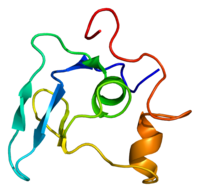
Photo from wikipedia
BACKGROUND Marfan syndrome (MFS) is an autosomal dominant multisystem disorder caused by mutations in the fibrillin-1 gene (FBN1). A small portion of them is copy number variations (CNVs), which can… Click to show full abstract
BACKGROUND Marfan syndrome (MFS) is an autosomal dominant multisystem disorder caused by mutations in the fibrillin-1 gene (FBN1). A small portion of them is copy number variations (CNVs), which can occur through recombination-based, replication-based mechanisms or retrotransposition. Not many have been characterized precisely in MFS. METHODS A female patient with suspected Marfan syndrome was referred for genetic testing at our institute. After systematic sequencing of FBN1, TGFBR1, and TGFBR2 genes, multiplex ligation-dependent probe amplification was applied. Long-range PCR, subsequent Sanger sequencing with designed primers, and preliminary in silico analysis were applied for the precise characterization of the breakpoints. RESULTS Primary analysis displayed a de novo large deletion affecting exons 46 and 47 in the FBN1 gene, which resulted in the loss of the 31st and 32nd calcium-binding EGFlike domains. Further examination of the breakpoints showed a 4916 nucleotide long deletion localized in intronic regions. Surprisingly a 'TG' dinucleotide insertion was detected at the junction. We hypothesize that the CNV formation was generated by a rare event based on the known microhomology-mediated break-induced replication (MMBIR). CONCLUSION An increasing number of CNVs are associated with Mendelian diseases and other traits. Approximately 2-7% of the cases in MFS are caused by CNVs. Up to date, hardly any model was proposed to demonstrate the formation of these genomic rearrangements in the FBN1 gene. Hereby, with the help of previous models and breakpoint analysis, we presented a potential mechanism (based on MMBIR) in the formation of this large deletion.
Journal Title: Current molecular medicine
Year Published: 2022
Link to full text (if available)
Share on Social Media: Sign Up to like & get
recommendations!